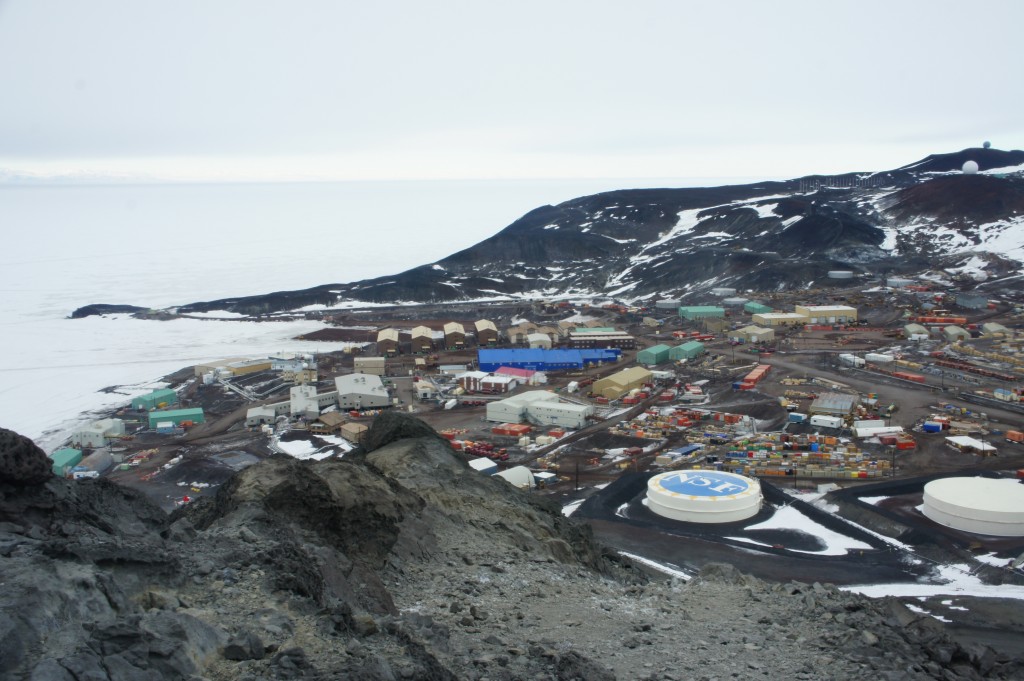Alum Elin McIlhattan shares stories about her fieldwork with the Antarctic Meteorological Research Center

How does a person get from a little farm in unincorporated Multnomah County, Oregon, to McMurdo Station, Antarctica?
For UO alumna Elin McIlhattan, the answer is a lot of hard work and a passion for science – as demonstrated by two University of Oregon Chemistry degrees and her current status as a PhD candidate at the University of Wisconsin–Madison.
Elin earned her UO Bachelor of Science degree in Chemistry in 2006, followed by a Masters in Chemistry through the UO Masters Industrial Internship Program, Polymers and Coatings track, in 2007. She is currently in her third year of a PhD program in Atmospheric and Oceanic Sciences at UW-Madison, studying polar cloud properties using satellites and models – which is how Antarctica entered the picture.
Soon after arriving at UW-Madison in 2013, a fellow graduate student introduced Elin to the scientists that work in the Antarctic Meteorological Research Center (AMRC). Having always loved fieldwork, Elin let them know that if there was ever an opening on their team, she wanted a chance to apply. That opening turned up the following season, so Elin worked to get her advisor on board, passed all the physical qualifications, and in December 2014 found herself on a LC-130 bound for McMurdo Station.
From mid-December 2014 to early February 2015, Elin worked as part of a four-member team installing new stations, updating equipment, and conducting repairs on the Antarctic Automatic Weather Station (AWS) network. AWS is the largest network of instruments in the Antarctic, and its primary purpose is to measure Antarctica’s surface climatology. Datasets collected by the stations, some going back 20 to 30 years, can provide researchers with essential observational records that will help identify signs of climate change in the Antarctic. An article about Elin’s research, “The impact of polar clouds,” was recently published online in Physics Today.
When asked what she liked best about working in Antarctica, Elin said that her favorite part of the experience was the team that she worked with.
“Dave [Mikolajczyk], Carol [Costanza], and Lee [Welhouse] are all experienced scientists, but also approachable and still filled with excitement about their work in Antarctica,” Elin said. “Much of the work I did in McMurdo was not glamorous – hauling batteries and sorting hardware – but it was satisfying because I was helping to make sure everything would go right when we were able to fly out and repair stations.”
Now, station repairs might sound pretty routine, but in Antarctica, even routine tasks can turn into adventures.

“One highlight was our repair visit to the station Laurie II,” Elin said. “This station had not been serviced in many years, and it took a while to find. Because it was on the moving ice shelf, it was about five miles from that last GPS coordinates we had, and it had been buried nearly to the top by years of snow accumulation. It was a clear day, so the helicopter pilots felt comfortable leaving us for a few hours to do the repairs. So they helped us unload all of our tower sections and equipment, put out survival bags in case they could not return right away, and flew off to do other work. We spent hours digging out the station’s electronics and instruments, adding tower sections, putting everything back on, and running tests to make sure data was being collected and transmitted. Once we were finished, we radioed the pilots to come back for us, but they were not able to come right away. We ended up finding some large ice chunks we’d chipped off during the dig out and played a little baseball with those and the shovels. It was a successful, beautiful, and very surreal afternoon.”
After earning her PhD, Elin plans to complete a postdoc and pursue a career in a government organization such as NASA, NOAA or NCAR.
Her inspiration, she explains, is that, “In science, everyone is able to make a meaningful contribution. You don’t have to discover something brand new or make a giant breakthrough to contribute, you simply have to make progress on some small part that fascinates you. All of the small, individual contributions add up to advances as a society in understanding the complex universe around us. I’m constantly inspired by the community of scientists I am a part of, each working on their piece of the puzzle.”
And sometimes, solving that next piece of the puzzle means a visit to the ends of the earth.
by Leah O’Brien
UO Chemistry and Biochemistry
